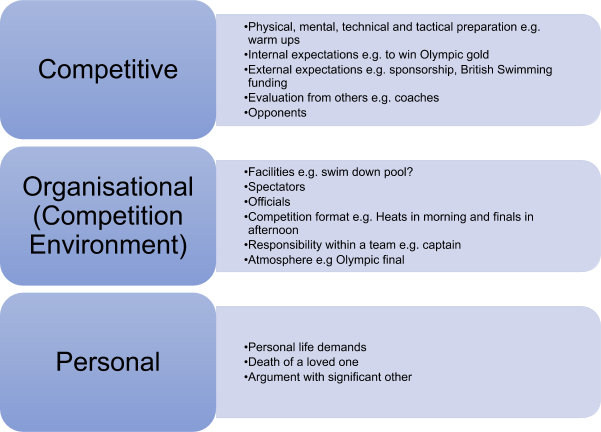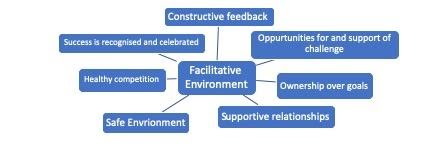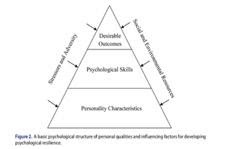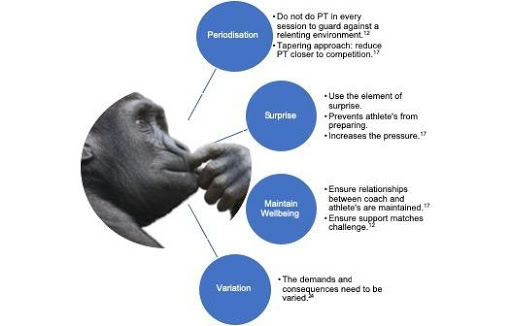By Ross Hill
“That one race every four years, you have to be perfect. Yeah, it adds a lot of pressure.”- Matt Grevers [1]

This pressurised environment has not gone unnoticed by British Swimming who have the vision that all swimmers will produce a “lifetime-best performance under the greatest of pressure,” [2] BUT do coaches have enough information on how to develop their athletes for this? NO, leaving many scratching their heads.
Coaches! Yes! You! It’s time to contemplate no longer for the intention of this blog, the purpose now is to equip you with the knowledge to better prepare your athletes and to empower them to thrive under pressure. We will take you on a journey that will uncover:
- The reasons swimming is pressurised;
- How well prepared your athletes are;
- The theory and research conducted into a concept entitled ‘pressure training’ (PT) and
- How this can be implemented immediately into your programme.
The Pressure of Elite Swimming
Elite swimming stressors are defined as any demand or combination of demands which “increases the importance of performing well on a particular occasion” [4] and can be split into three types [3,5]:

With the inauguration of the International Swimming League (ISL), one of the most profound pressures that has been elevated in recent times is monetary reward with around $7million to be shared out amongst athletes during the 2019 edition. What will remain constant, however, is the concentrated pressure that is involved when competing in an Olympic final as described by Eamon Sullivan (3x Olympian; 2012):
“The difference between world championships and the Olympics is a hundred times more pressure.” [7]
Are Elite Level Swimmers Prepared for These Pressures?
The U.S National Team Director (Lindsay Mintenko) certainly believes their swimmers are:
“We’ve been using the U.S. O.T.C. [Olympic Training Centre] quite a bit and their expertise to help us prepare for any kind of abnormal circumstances”
However, can rehearsing a change in time zone really be the answer? Of course it can’t and to assume so is naïve. For example, it cannot mediate the pressure of knowing “Wow, if I don’t swim fast, I don’t get my paycheck” [8]. As a result, swimmers may be vulnerable to a performance decrease [9,10] as highlighted by Sullivan (2012):
“We under-prepared for the expectations of the pressure and the experience”[7]
Choking is where an individual performs below their expected level of performance and demonstrates an inability to cope with pressure[9]. If swimmers are to achieve their internal ambitions, they must posse the ability to thrive on pressure[11]. The ability to use one’s own qualities to combat and thrive on pressure is termed ‘Psychological Resilience’.[12]
The Issue with Current Training
It appears logical that coaches should be constructing sessions that enable an individual to develop resilience[13] by exposing them to stressful and challenging situations.[14,15] However, modern training regimes favour an approach which builds self-belief that is ‘unbreakable under pressure’ [10,16] via the development robust psychological skills.[10] Instead elite swimmers need to have PT implemented[11] to place them under the same/similar pressurised circumstances they will face on race day[17]. PT can be defined as subjecting swimmers to different stressors which challenge their goals, allowing them to improve their coping ability and subsequent performance in future pressurised situations.[10,17,18]
PT: Theory
The most insightful theoretical base that outlines the use of PT is the mental fortitude (resilience) training program[12]:

PT: Environment
Coaches must carefully construct an environment where individuals are placed under the appropriate level of stressful demands, [11] whilst increasing support.[12]

PT: Individual
When seeking success, an individual’s personal qualities are placed under pressure. Personal qualities are made up of 3 tiers:[12]

Coaches must operate at the psychological skills level of the model in addition to providing social and environmental resources. If an athlete is trained in some of the psychological skills through PT, then this combined with personality characteristics will lead to more desirable outcomes improving performance under pressure. To understand whether support through psychological skills training needs to be increased or challenged, coaches should refer to the below flow diagram:[12]

PT: Challenge Mindset
PT allows individuals- through acclimatisation- to recognise pressure and cope better by developing their own strategies.[10,15,17] Therefore, the athlete will evaluate the situation as a challenge rather than a threat.[12] Enabling elite swimmers to recognise their own negative thinking patterns and transfer them into positive thoughts. This could allow individuals to use their anxiety to improve performance which was suggested to be a key differentiating factor between successful and unsuccessful gymnasts.[19]
Effectiveness of PT
PT can elicit the psychological and biological changes associated with pressure- namely anxiety[15] . For instance, 15 England international netball players underwent a PT intervention and it was found that heart rate, cognitive anxiety and perceived pressure were all increased.[18] These findings have been replicated in elite disability shooters,[20] basketball players and experienced dart players.[15]
Furthermore, PT often increases performance in future pressurised competitions. This was demonstrated in youth cricketers with a significant increase in both the multi-stage fitness test and indoor batting ability,[10] shooters,[21] experienced dart players and basketball players.[15] Coaches who implemented PT also believed their athletes were better prepared for competition. This resulted in performance gains.[22]
Further support is evident in its use for the treatment of anxiety and phobia related disorders. For example, systematic desensitisation uses graded exposure to fearful stimuli[17] to evoke an anxiety response which the individual learns coping skills to reduce.[23] Stress inoculation training extends systematic desensitisation where an individual is firstly taught to understand the problem they have with stress. They are then taught a variety of coping skills and finally exposed to the stressors with the aim of using these skills[23] as seen within PT.[12]
PT: A Guide

Step 1: Identify Decision Makers
The first step is to identify those who could have a positive or negative influence on the intervention.[12] It is essential that all stakeholders are effectively communicated a collective vision that highlights their role to ensure their commitment. [10,12] Key stakeholders in elite swimming may include:
· Coaching assistants;
· The swimmers themselves;
· British swimming;
· Strength and conditioning coaches and
· Physiotherapists.
Step 2: Pressure Analysis
A meeting should be set up between all coaches and swimmers in which an open discussion is conducted [24] to conceptualise key themes:[25]
- Self-reflection of the swimmer’s own reactions to stress, drawing on past experiences;[11]
- Determine the antecedents of pressurised situations and the role their thinking and feelings played in how they responded;[26]
- Assess the short and long-term impact their behaviour had;[26]
- Educate swimmers on the ‘resilience’ concept and transform the thinking that it is a performance-limiting weakness[12] and
- Develop an exposure hierarchy where situations are ranked on the level of anxiety caused[26].
Part 3: Psychological Skills Training (PST)
Coaches must then make a choice between two opposing approaches:

Part 4: Implementation
PT should adopt an individualised graded exposure system which triggers an anxious fear response and ensure the athlete is kept in the situation for long enough to learn the threat is not real[26]. Coaches should increase the demands of the task and follow it up with increased consequences for failing.[24] To ensure the task is best representative of competition, coaches should (although not limited to) replicate one of the events the swimmer competes in within a training context e.g. Stand-up 200m Butterfly.
Increasing the Demands
Demands are “how physically and cognitively challenging the PT was” [22]
In line with mental fortitude theory,[12] PT makes a task more difficult to accomplish by placing three stressors on the individual: task, performer and environmental.
Task Stressors

Anything in the situation which increases the demand of it[22] e.g. rules and officials. In a pressurised situation, coaches can create task stressors through:
- Novel activities such as taking part in other sports[17] e.g. football, gymnastics etc,
- Making an athlete do a set distance without taking a breath drawing on previous research with basketball where limits were given for a given skill,[24]
- Let swimmers compete head to head with an advantage for one swimmer over the other, followed up with consequences for the loser,[17]
- Set time limits for stand-ups[17] e.g. a countdown clock and
- Deliberate bad call for DQ. The individual must then do the consequence irrespective of the time they went, increasing the pressure placed upon them through feelings of injustice.[24]
Performer Stressors

Any stimuli that impacts or has the potential to impact upon the mental and physical capabilities of the swimmer.[22]
In PT a coach can achieve this in many ways:
- Fatigue the swimmer before the PT task, to reduce their capabilities to perform increasing the challenge ahead[22] This could be done through suicide sprints[24], a gym session or a hard threshold session followed by a pressure training context which utilises some of the task stressors above with further consequences,
- Racing after travelling all night,[17]
- Deliberately making mistakes on travel arrangements or faking a vehicle breakdown meaning warmups and preparations are missed or must be adapted,[17]
- Use of an online Stroop test before the pressurised situation to cognitively fatigue the swimmer,[20]
- Fill goggles with water and do a stand-up. If they fail to hit a certain time, then consequences are imposed. This draws upon research with elite netball players where the use of occlusion goggles, when performing a closed skill, increased pressure and reduced resultant performance and[18]
- Deliberately choose open meets where the swimmer will or may not be the best to challenge their capabilities to win.[17]
Environmental Stressors
Manipulation of the surroundings that an individual trains within. This includes the sounds, temperature and visual aspects[22]. Coaches who have implemented these stressors highlight that they should replicate the competition environment as closely as possible[22] to ensure ecologically validity.[18]

Below are some examples a coach can implement:
- Manipulate the temperature of the poolside making it hotter or colder, [18,20]
- Manipulate the lighting of the poolside[18,20]. Replicate a final where lights may be turned down when walking out and then very intense before the race commences,
- Introduce loud crowd noise over the speakers when doing stand-ups,[17,18,20]
- Make swimmers race or train in deliberately poor/challenging facilities[15] such as on a training camp and[17]
- Use lane assignments as if it was a final and replicate the competition exactly with referee’s, starters, crowd, warm up allocations etc.[17]
Increasing the Consequences
Currently academics are divided on whether increasing the demands of a situation is enough, for example research with dart players found demands were successful in increasing pressure.[15] However, research with elite disability shooters [20] and netball players[18] have not reproduced these findings. It is therefore argued that a coach must also increase the consequences in collaboration.[10,18,20] There are three ways a coach can increase consequences:
- Forfeit’s;
- Rewards and
- Judgements
It is essential whenever consequences are administered that it was made clear to the performer before the challenge begins that this would happen, when it would happen and why. Furthermore, there must be no grey area between success and failure.[10]
Forfeit’s
Punishment[22]:
- Physical[15,17,18,24] e.g. 400m Butterfly, 20-minute run, push-ups etc,
- Make the session even harder to a level that is impossible to achieve, so perceived exertion goes over 100% and max heart rate is reached,[17]
- Perform a staged media conference in front of a high-profile panel e.g. British swimming representatives, coach and peers, for 5 to 10 minutes with questions relating to why they failed at the given task. This was shown to have a significant effect on increasing pressure with elite disability shooters,[20]
- Video record a one-minute presentation, upload to social media and leave for an extended time frame. Themes used with netball players: Who they admire in the team and why? Produce a comedy piece and talk about why you could be the best in the world,[18]
- Put everybody’s kit away at the end of the session,[10]
Potential removal of something positive[22]:
- Miss the next training session,[22]
- Less contact time with coach (but must be carefully approached) and[18]
- Don’t select for a relay.[17]
Reward Stressors
These stressors refer to the chance of gaining something positive.[22]
Examples that coaches can draw upon are as follows:
- Allowing the successful athlete to plan a future session or give them extra support,[22]
- Race for better accommodation at a hotel,[17]
- Provide a monetary incentive such as a £50 voucher[15,18,20] and,
- Exemption from the forfeit[18]
Coaches should utilise both forfeits and rewards.[20]
Judgement Stressors
A coach creates a situation where the athlete may be evaluated positively or negatively by a valued individual[22]. Coaches could use some of the following strategies:
- Talk to the swimmer directly about their expectations of performance before a given task,[22]
- The attendance of a performance director at a pressurised training session where their evaluation is made explicitly clear to the athlete[20,22] and
- Pretend to record a stand up and tell swimmers that it will be sent to other coaches to be reviewed.[15]
Results from previous studies found that judgement stressors of this nature worsened performance due to increased pressure,[20] showing it to be an effective PT technique.
Key Considerations for PT

Key Points
- Swimming is a highly pressurised unrelenting environment;
- Modern training regimes do not prepare an athlete adequately;
- Coaches should create an environment where challenge and support are balanced, personal qualities are developed and a challenge mindset is nurtured;
- PT should begin with identifying decision-makers, conducting a pressure analysis and training of athletes in psychological skills training;
- Coaches can implement PT by increasing the demands (Task, Performer, Environmental) as well as increasing the consequences (Forfeit, Reward, Judgement) for not succeeding at a given task;
- PT needs to be periodized, surprising in nature and varied and
- Mental wellbeing should be maintained at all times!
You can find the full blog post with all of the references here.

Ross Hill is a 22-year-old MSc Sport & Exercise Psychology postgraduate at Loughborough University. Previously he had an eleven-year career with Chase SC and Loughborough University Swimming at the national level.
After completing his BSc Psychology degree he decided to specialize in Sport and Exercise Psychology with a particular interest in performance psychology. Hill also works as a Sport & Exercise Psychology Programme assistant with the Tennis team at the university. He holds a Swim England Level 2 coaching qualification and offers his services to Loughborough University Swimming when requested. In the future, he hopes to become a fully qualified Sport and Exercise Psychologist and undertake a PhD within performance psychology in swimming.

Very poor advice, confabulation at its best.
A link to the scientific-based literature is provided at the end of the article.